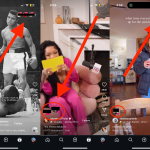I was delighted to sign on to this amicus brief supporting the challenge to Texas’s S.B. 12 (Woodlands Pride, Inc. v. Paxton (5th Cir.)), which was filed on behalf of Prof. Dale Carpenter (SMU), Dean Erwin Chemerinsky (Berkeley), the Stanton Foundation First Amendment Clinic at Vanderbilt Law School, and me. Here’s a summary of the Texas statute, from the brief:
{S.B. 12 restricts “[s]exually oriented performance[s],” which are defined as one that features nudity or “sexual conduct” and “appeals to the prurient interest in sex.” See Tex. Penal Code § 43.28(a)(2). Sexual conduct, in turn, is defined as, among other things, “the exhibition of sexual gesticulations using accessories or prosthetics that exaggerate male or female sexual characteristics.” Id. § 43.28(a)(1)(E). None of the key terms—”sexual gesticulations,” “accessories or prosthetics,” “exaggerate”—are further defined.
Texas restricts these performances three ways: (1) S.B. 12 criminalizes the performers by making it a crime to “engage[] in a sexually oriented performance” “on public property” where it “could reasonably be expected to be viewed by a child” or “in the presence” of a minor, id. § 43.28(b); (2) it regulates non-public, commercial properties by prohibiting anyone who controls the premises of a commercial enterprise from allowing a restricted performance on the premises in a child’s presence, Tex. Health & Safety Code § 769.002; and, (3) it proscribes a municipality or county from authorizing such a performance “on public property” at all or “in the presence of an individual younger than 18,” Tex. Loc. Gov’t Code § 243.0031(c)(1)–(2). The defined performances are banned regardless of whether they have literary, artistic, political, or scientific value.}
Here’s the summary of the argument:
[S.B. 12] is an unconstitutional content-based restriction on First Amendment-protected speech. The Supreme Court has repeatedly held that similar laws targeting “sexually oriented” speech are content-based and subject to strict scrutiny.
Even though S.B. 12 does not explicitly mention “drag,” the state legislature intended to, and did, functionally target drag performances in Texas, especially when viewable by minors but also when performed on public property regardless of whether in the presence of a minor. See Tex. Penal Code § 43.28(b) (criminalizing “engag[ing] in a sexually oriented performance” “on public property” where it “could reasonably be expected to be viewed by a child” or “in the presence” of a minor); Tex. Health & Safety Code § 769.002 (regulating non-public, commercial properties by prohibiting anyone who controls the premises of a commercial enterprise from allowing a restricted performance on the premises in a child’s presence); Tex. Loc. Gov’t Code § 243.0031(c)(1)–(2) (proscribing a municipality or county from authorizing such a performance “on public property” at all or “in the presence of an individual younger than 18”); Tex. Loc. Gov’t Code § 243.0031(c)(1) (banning municipalities from permitting the restricted performances on public property, full stop); see also Senator Hughes, C.S.S.B. 12 Author’s / Sponsor’s Statement of Intent (Mar. 30, 2023) (calling for an end to the “recent cultural trend … for drag shows to be performed in venues generally accessible to the public”). For these reasons, S.B. 12 is subject to strict scrutiny.
Texas contends that S.B. 12 is not subject to strict scrutiny because it allegedly only bans obscenity and, furthermore, is directed only at the “secondary effects” of the restricted speech. However, neither of these exceptions to strict scrutiny applies here. S.B. 12 restricts far more than obscene speech. Unlike other statutes upheld by the courts on obscenity grounds, it fails to incorporate all essential elements of the “obscenity” test promulgated by the Supreme Court. See Miller v. California, 413 U.S. 15, 24 (1973). Contrary to the statements made by the bill’s sponsors, see infra, drag performance, even sexually provocative drag performance, is not obscene under Miller. In one glaring omission, S.B. 12 has no exception for speech that has literary, artistic, political, or scientific value.
And the so-called “secondary effects” of the targeted performances raised by Texas—the purported harm to children—is instead a direct effect of the speech, a content-based justification requiring the application of strict scrutiny. Analyzing this exact justification for a similar law, the Supreme Court explicitly held that the “secondary effects” doctrine was “irrelevant.” United States v. Playboy Ent. Grp., 529 U.S. 803, 806, 812, 815 (2000); see also Texas v. Johnson, 491 U.S. 397, 412 (1989) (holding that a law based on the communicative or emotive impact of speech on its audience is content based and subject to “the most exacting scrutiny” (quoting Boos v. Barry, 485 U.S. 312, 321 (1988))). So, too, here.
Because S.B. 12 must be subject to strict scrutiny and is not narrowly tailored to achieve Texas’s asserted interest—it is overbroad and lacks a parental consent exception—it should be struck down.
And here’s an excerpt from the discussion of the obscenity exception:
S.B. 12 prohibits speech that does not meet the test for obscenity in Miller. It only adopts one part of the first prong of the Miller test: that a performance is banned if it “appeal[s] to the prurient interest in sex.” Tex. Penal Code § 43.28(a)(2)(B). It fails to satisfy or even address the rest of the test. S.B. 12 is not limited to depictions of “patently offensive ‘hard core’ sexual conduct,” such as those that depict “ultimate sexual acts, normal or perverted,” “masturbation, excretory functions, and lewd exhibitions of the genitals.” Miller, 413 U.S. at 25, 27; e.g., Hoover v. Boyd, 801 F.2d 740, 741 (5th Cir. 1986). As discussed below, S.B. 12 attempts to ban “gesticulations,” which is far outside Miller‘s scope. It also does not make any leeway for “contemporary community standards” and does not consider “the work as a whole,” see Miller, 413 U.S. at 24, which “is critical when it comes to the exercise of free speech, especially when, as here, its exercise has criminal consequences.” Netflix, Inc. v. Babin, 88 F.4th 1080, 1098 (5th Cir. 2023) (criticizing prosecutor for failing to “show the grand juries the entire length of the film (or even the more immediate context of the few scenes he showed)”). And, importantly, it fails to contain a carveout for sexually oriented performances that have artistic or political value. See Ashcroft, 535 U.S. at 578 (noting that a key reason the court struck down the Communications Decency Act in Reno was that the statute failed to “exclude[] from the scope of its coverage works with serious literary, artistic, political, or scientific value”); see also Book People, Inc. v. Wong, No. 23-cv-00858, 2023 WL 6060045, at *20–21 (W.D. Tex. Sept. 18, 2023) (holding that a statute does not meet Miller test where its definition of “sexually relevant material” does not include consideration of literary, artistic, political, and scientific value), aff’d in part, vacated in part, & remanded on other grounds, 91 F.4th 318 (5th Cir. 2024).
S.B. 12 also fails to “specifically define[]” the “sexual conduct” it proscribes. See Reno, 521 U.S. at 870–72 (vague prohibition on patently offensive sexual material is “problematic for purposes of the First Amendment”). For example, S.B. 12 prohibits “the exhibition of sexual gesticulations using accessories or prosthetics that exaggerate male or female sexual characteristics,” but there is no real telling what that means, despite Texas’s attempts to do so in its brief. See, e.g., HM Fla.-ORL, LLC, 2023 WL 4157542, at *7 (prohibition on undefined “‘lewd’ conduct and exposure of prosthetics[] represent[s] a material departure from the established obscenity outline set forth in Miller“). Texas argues that, to the extent drag performers are merely shimmying, shaking, or twerking, they are not engaged in “sexual gesticulations.” Tex. Br. at 15. But the dictionary definition of “gesticulation,” as Texas itself cites, is quite broad, covering any “expressive gesture made in showing strong feeling or in enforcing an argument.” Id. (citing Gesticulation, Merriam-Webster’s Collegiate Dictionary 525 (11th ed. 2003)). Nearly every performer “gesticulates” and shows “strong feeling” during a show or while dancing.
Nor does the modifier “sexual” meaningfully limit the prohibition, if it provides a limitation at all. “Sexual gesticulation”—a term S.B. 12 leaves undefined—easily encompasses run-of-the-mill dancing—including tango, salsa, twerking, Elvis’s hip thrusts—all of which involve sexually “expressive gestures” with one’s body. Moreover, drag performers often use prosthetics to imitate and exaggerate sex characteristics, including breastplates or packers. If they do, and “show strong feeling,” S.B. 12 makes them criminals. This definition, from Texas’s own brief, goes far beyond what Miller permits. See 413 U.S. at 27 (“Under the holdings announced today, no one will be subject to prosecution for the sale or exposure of obscene materials unless these materials depict or describe patently offensive ‘hard core’ sexual conduct ….”).
This Court’s recent decision in Free Speech Coalition does not compel a different result. There, the panel (over a vigorous dissent) held that laws protecting minors from content that is obscene for minors need only pass rational-basis review. 95 F.4th at 267–69. But the age-restriction for pornography websites considered in that case is vastly different from the law here. First, the regulation at issue in Free Speech Coalition only blocked minors from viewing pornography online; any adult could continue to view the content by simply verifying their age. Id. at 275 (“H.B. 1181 allows adults to access as much pornography as they want whenever they want.”). S.B. 12, in contrast, prohibits these performances on any public property, regardless of whether a minor is present or not, and it criminalizes the performers even on private property merely if a child “could reasonably be expected to” view their show, which restricts (and chills) much more adult-access to protected speech than an age-verification requirement. Id. at 276 (“The law in Ginsberg, like H.B. 1181, targeted distribution to minors; the law in Playboy targeted distribution to all.”). S.B. 12, by precluding adults from viewing banned performances that would otherwise take place, is much more like the regulation in Playboy, which restricted when an adult could view a “sexually-oriented” television programming because a child would be likely to view it at that time. See 529 U.S. at 806–07. Second, the law in Free Speech Coalition restricted content by incorporating each portion of the Miller obscenity test, merely appending “for minors” to every prong. Free Speech Coal., 95 F.4th at 267. S.B. 12, in contrast, only incorporates one portion of the Miller test. Accordingly, S.B. 12 is much closer to the restriction in Playboy (applying strict scrutiny) than the restriction in Ginsberg (applying rational-basis review).
S.B. 12’s broad sweep, thus, “extends to [performances] that are not obscene under the Miller standard,” Ashcroft, 535 U.S. at 235, and it restricts the ability of adults to view the prohibited speech even though the law is primarily (though not exclusively) targeted to minors. Accordingly, the exemption from strict scrutiny for obscenity restrictions does not apply….
The post Brief Challenging Texas Restriction on “Sexual Gesticulations Using Accessories or Prosthetics That Exaggerate … Sexual Characteristics” appeared first on Reason.com.






